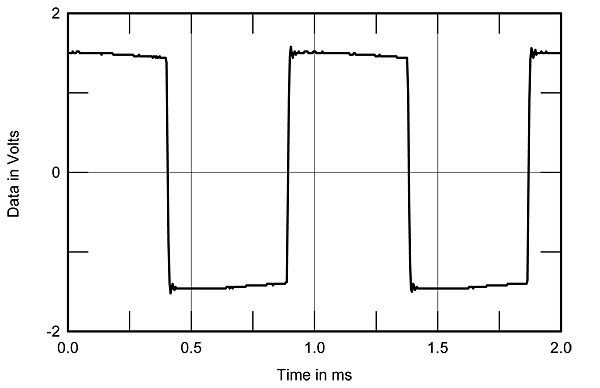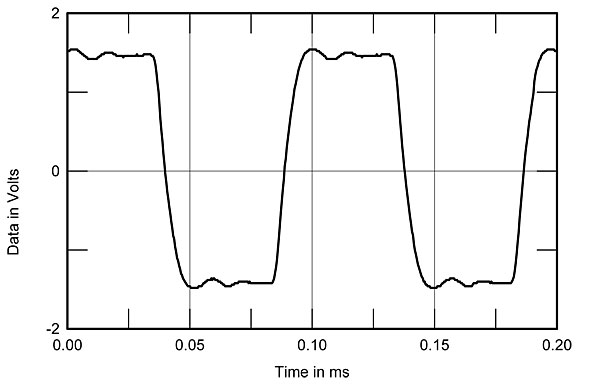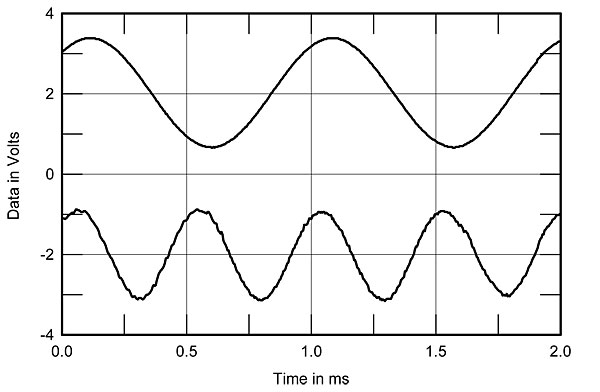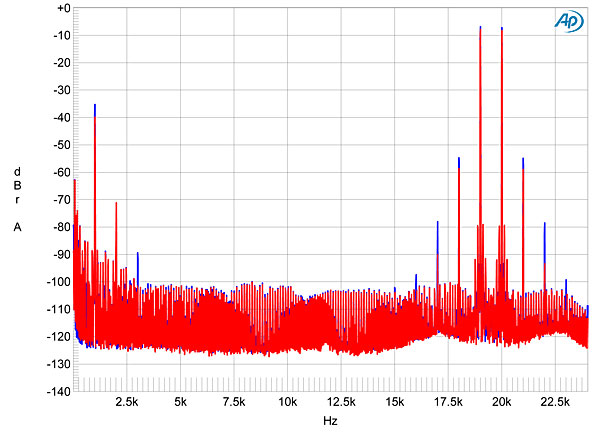| Columns Retired Columns & Blogs |
Drop dead gorgeous!
To perform the measurements on the Audio Note Jinro, I mostly used Stereophile's loan sample of the top-of-the-line Audio Precision SYS2722 system (see the January 2008 "As We See It" and www.ap.com); for some tests, I also used my vintage Audio Precision System One Dual Domain. I made sure I installed the tubes in the correct sockets, though I didn't realize at first that the big 211s have a bayonet fitting: to engage the electrical contacts, you push down and twist. Otherwise nothing happens. I ran the amp for a couple of hours before attempting any tests.
The voltage gain into 8 ohms was low for an integrated amplifier and slightly different for the two channels, at 32.5dB left and 32.9dB right. The output preserved absolute polarity (ie, was non-inverting). The input impedance was slightly but inconsequentially lower than the specified 100k ohms, at 60k ohms at low and midrange frequencies and 44k ohms at the top of the audioband. The output impedance from the single transformer tap was commendably low for a single-ended-triode design, at 2.5 ohms, which resulted in frequency-response variations of +1.6dB/–1.2dB into our standard simulated loudspeaker (fig.1, gray trace). The 0.4dB channel imbalance can also be seen in this graph, but the response is otherwise fairly wide and flat.

Fig.1 Audio Note Jinro, volume control at maximum, frequency response at 1V into: simulated loudspeaker load (gray), 8 ohms (left channel blue, right red), 4 ohms (left cyan, right magenta), 2 ohms (green). (1dB/vertical div.)
Fig.1 was taken with the volume control set to its maximum, which gives an 8-ohm response that is down 1dB at 20kHz. Repeating the measurement at the same output level but with the volume control set to 12 o'clock gives a response that is now just –0.3dB at 20kHz (fig.2). I used a different scale for this graph, to show the two well-suppressed peaks at 80 and 120kHz. These peaks do give rise to a small degree of overshoot and ringing on the 1 and 10kHz squarewave responses (figs.3 and 4, respectively), but again, this is pretty good behavior for a SET amplifier.

Fig.2 Audio Note Jinro, volume control at 12:00, frequency response at 1V into: 8 ohms (left channel blue, right red; 2dB/vertical div.).

Fig.3 Audio Note Jinro, small-signal 1kHz squarewave into 8 ohms.

Fig.4 Audio Note Jinro, small-signal 10kHz squarewave into 8 ohms.
Channel separation (not shown) was good, at 70dB at 2kHz, L–R, and 78dB at 3kHz, R–L, but decreased a little at the frequency extremes, to 50dB at 20Hz and 60dB at 20kHz. Given that the two small-signal tubes are shared between the channels, the latter is actually quite good. I did find some adjacent input crosstalk; eg, when Input 1 was being driven with a 1kHz signal at an input level that gave an output power of 8W into 8 ohms, switching to Input 2 gave a level at the output of 12.7mV, or –56dB. Unusually, this was not affected by inserting a shorting plug in the undriven input.
The two channels differed in signal/noise ratio, mainly because the left channel suffered from some 60Hz hum that I couldn't eliminate by experimenting with the grounding between the amplifier and the test system. The unweighted, wideband S/N ratio (ref. 1W into 8 ohms, with the input shorted by the volume control set to its maximum) was 44.6dB left and 61.7dB right. These figures improved to 58.7 and 79.9dB, respectively, when A-weighted.
The two channels also differed when it came to linearity, the left, lower-gain channel having somewhat higher distortion than the right. Using the better-measuring right channel, I plotted the manner in which the THD+noise percentage changed with output power (fig.5): The maximum power delivery was obtained into 8 ohms (second trace from bottom), suggesting that the output transformer is optimized for this load, though the 16 ohm performance (bottom trace) wasn't far behind. The actual distortion was below the noise at powers below 100mW into 16 and 8 ohms, but the linear rise with THD above that level suggests that Jinro uses very little global negative feedback, or even none at all. As a result, the amplifier's distortion reaches 1%, our usual definition of clipping, long before symmetrical waveform clipping occurs.

Fig.5 Audio Note Jinro, distortion (%) vs 1kHz continuous output power into (from bottom to top): 16, 8, 4, 2 ohms.
The power delivery at 1% THD is low: 8W into 16 ohms, 3.1W into 8 ohms, 1W into 4 ohms, and just 300mW into 2 ohms. Relaxing the definition of clipping to 3% THD gives powers of 12W into 16 ohms, 17.7W into 8 ohms, 5.1W into 4 ohms, and just 2.3W into 2 ohms, which suggests that Audio Note's specification of 18Wpc into 8 ohms at 5% THD (12.55dBW) is correct.
I plotted how the THD+N percentage changed with frequency at 1V (fig.6). You can see that the right channel is more linear/quieter than the left, and that the THD decreases with increasing load impedance. Fortunately, the distortion spectrum primarily consists of the subjectively innocuous second harmonic (fig.7), though there is some third harmonic present, along with some AC-supply–related spuriae (fig.8), particularly in the left channel (blue trace).

Fig.6 Audio Note Jinro, THD+N (%) vs frequency at 1V into: 16 ohms (left channel gray), 8 ohms (left blue, right red), 4 ohms (left cyan, right magenta), 2 ohms (left green).

Fig.7 Audio Note Jinro, 1kHz waveform at 250mW into 8 ohms (top), 0.47% THD+N; distortion and noise waveform with fundamental notched out (bottom, not to scale).

Fig.8 Audio Note Jinro, spectrum of 50Hz sinewave, DC–1kHz, at 1W into 8 ohms (left channel blue, right red; linear frequency scale).
The power-supply–related spuriae dominate the noise floor with the high-frequency intermodulation test (fig.9). However, while the Jinro's "bent" transfer function gives rise to a 1kHz difference product at just –36dB (1.5%, left) and –40dB (1%, right), other intermodulation products are relatively moderate in level. Note, though, that while the power level at which I took this measurement was well within the Jinro's capability, the primary tones have sidebands present at ±60 and ±120Hz, which suggests that the amplifier is starting to run out of steam.

Fig.9 Audio Note Jinro, HF intermodulation spectrum, DC–24kHz, 19+20kHz at 5W peak into 8 ohms (linear frequency scale).
The Audio Note Jinro actually measures well for a single-ended-triode design, with a relatively low output impedance, a fairly wide bandwidth, particularly at low frequencies, and good suppression of the inevitable ultrasonic transformer resonances. But you can't escape that bent transfer function, or the fact that the Jinro's performance will depend on the tubes used. As Art Dudley asked in his conclusion, "Do single-ended amplifiers sound wonderful because they're uniquely true to the music, or do they sound wonderful because they falsify and misshape the music, however appealingly?" I wish I had an answer to that question.—John Atkinson


Every blossom in spring is as perfect as need be.
We enjoy racing our pet turtles, but, the magic is lost on them.
What was your favorite note in the song that just finished?
Streamer really pulls the music free of its digital dungeon.
Hurrah!